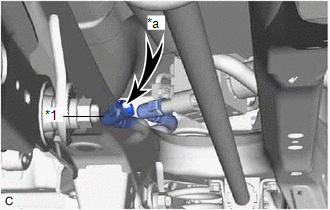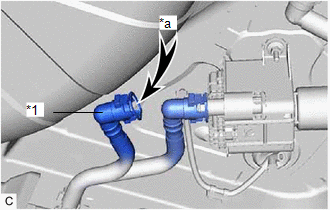| Last Modified: 05-13-2024 | 6.11:8.1.0 | Doc ID: RM1000000026FN3 |
| Model Year Start: 2023 | Model: Corolla Hatchback | Prod Date Range: [09/2022 - ] |
| Title: M20A-FKS (EMISSION CONTROL): EMISSION CONTROL SYSTEM (w/ Canister Pump Module): ON-VEHICLE INSPECTION; 2023 - 2025 MY Corolla Corolla Hatchback [09/2022 - ] | ||
ON-VEHICLE INSPECTION
CAUTION / NOTICE / HINT
CAUTION:
- When working near the engine room while the engine has started or the power source mode is engine switch on (IG), do not touch the fan and generator V belt or rotating components such as the fan, etc.
- Touching the fan and generator V belt or rotating components such as the fan, etc. could result in your hand or clothing getting caught and pulled in.
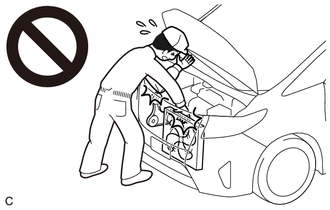
PROCEDURE
1. INSPECT FUEL CUT OPERATION
CAUTION:
- When working near the engine room while the engine has started or the power source mode is engine switch on (IG), do not touch the fan and generator V belt or rotating components such as the fan, etc.
- Touching the fan and generator V belt or rotating components such as the fan, etc. could result in your hand or clothing getting caught and pulled in.
(a) Start the engine.
(b) Warm up the engine.
(c) Increase the engine speed to at least 3500 rpm.
|
(d) Using a sound scope, check for injector operating sounds. |
|
(e) When the accelerator pedal is released, check that injector operating sounds stop momentarily and then resume.
If the result is not as specified, check the injectors, wiring and ECM.
Standard:
|
Item |
Specified Condition |
|---|---|
|
Fuel cut off engine speed |
2500 rpm or higher |
|
Fuel injection restart engine speed |
1400 rpm |
2. VISUALLY INSPECT HOSES, CONNECTIONS AND GASKETS
(a) Visually check that the hoses, connections and gaskets have no cracks, leaks or damage.
NOTICE:
- Detachment or other problems with the engine oil dipstick, filler cap, ventilation hose or other components may cause the engine to run improperly.
- Air suction caused by disconnections, looseness or cracks in any part of the air induction system between the throttle body assembly and cylinder head sub-assembly will cause engine failure or engine malfunctions.
If any defects are found, replace parts as necessary.
3. INSPECT EVAPORATIVE EMISSION CONTROL SYSTEM
CAUTION:
- When working near the engine room while the engine has started or the power source mode is engine switch on (IG), do not touch the fan and generator V belt or rotating components such as the fan, etc.
- Touching the fan and generator V belt or rotating components such as the fan, etc. could result in your hand or clothing getting caught and pulled in.
(a) Connect the Techstream to the DLC3.
(b) Start the engine.
(c) Warm up the engine.
(d) Turn the Techstream on.
|
(e) Slide the clip and disconnect the fuel vapor feed hose from the purge valve (purge VSV). |
|
(f) Enter the following menus: Powertrain / Engine / Active Test / Activate the EVAP Purge VSV.
Powertrain > Engine > Active Test
|
Tester Display |
|---|
|
Activate the EVAP Purge VSV |
(g) Check that vacuum occurs at the purge valve (purge VSV) port.
(h) If vacuum does not occur, check the following items:
(i) Exit Active Test mode and connect the fuel vapor feed hose to the purge valve (purge VSV) and slide the clip to secure it.
(j) Enter the following menus: Powertrain / Engine / Data List / EVAP (Purge) VSV.
Powertrain > Engine > Data List
|
Tester Display |
|---|
|
EVAP (Purge) VSV |
(k) Warm up the engine and drive the vehicle.
(l) Confirm that the purge valve (purge VSV) opens.
If the result is not as specified, replace the purge valve (purge VSV), wire harness or ECM.
4. CHECK FUEL TANK AND VENT LINE
(a) Disconnect the fuel tank vent hose from the canister (charcoal canister assembly).
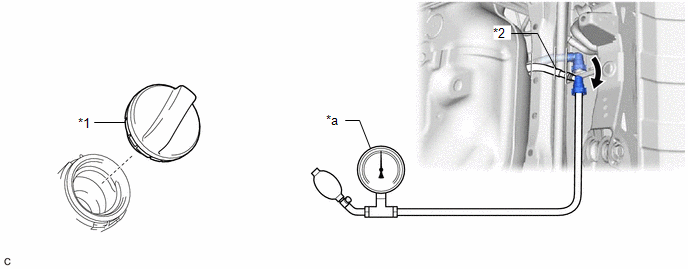
|
*1 |
Fuel Tank Cap Assembly |
*2 |
Fuel Tank Vent Hose |
|
*a |
Pressure Gauge |
- |
- |
(b) Connect a pressure gauge to the fuel tank vent hose.
(c) Apply 4 kPa (0.04 kgf/cm2, 0.6 psi) of pressure to the vent line of the fuel tank assembly.
HINT:
Perform this inspection with the fuel tank assembly less than 90% full. When the fuel tank assembly is full, the fuel fill check valve closes and the pressure is released through the 2 mm (0.0787 in.) orifice. As a result, when the fuel tank cap assembly is removed, the pressure does not decrease smoothly.
(d) Check that the fuel tank assembly pressure is maintained for some time and does not decrease immediately.
HINT:
If the pressure decreases immediately, one of the following may apply:
- The fuel tank cap assembly is not completely tightened.
- The fuel tank cap assembly is damaged.
- Air is leaking from the vent line.
- The fuel tank assembly is damaged.
(e) Remove the fuel tank cap assembly and check that the pressure is released smoothly.
If the pressure is not released smoothly, replace the fuel tank assembly.
(f) Connect the fuel tank vent hose to the canister (charcoal canister assembly).
5. INSPECT AIR LINE (for Double Wishbone Type Suspension)
|
(a) Disconnect the air line tube from the leak detection pump sub-assembly. |
|
(b) Check that air flows freely into the air line.
If air does not flow freely into the air line, repair or replace the air line tube.
(c) Connect the air line tube to the leak detection pump sub-assembly.
6. INSPECT AIR LINE (for Torsion Beam Type Suspension)
|
(a) Disconnect the air line tube from the leak detection pump sub-assembly. |
|
(b) Check that air flows freely into the air line.
If air does not flow freely into the air line, repair or replace the air line tube.
(c) Connect the air line tube to the leak detection pump sub-assembly.
|
|
|
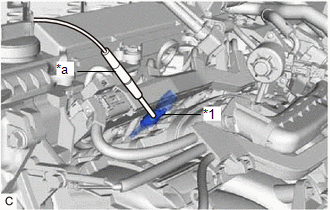

![2023 MY Corolla Corolla Hatchback [09/2022 - 11/2022]; M20A-FKS (ENGINE CONTROL): SFI SYSTEM: TERMINALS OF ECM](/t3Portal/stylegraphics/info.gif)
